The Great of the American Station Wagon
The Last, Great, Gasp of the American Station Wagon
Few true station wagons remain on the roads, but the imprint of their design influence is everywhere.
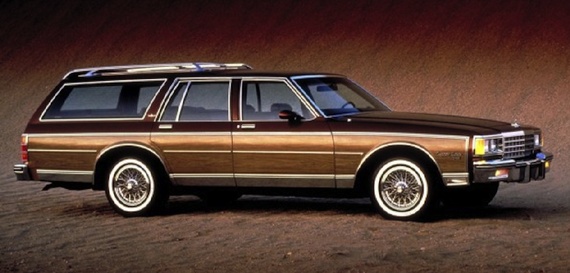
1985 Chevrolet Caprice ( Chevrolet Wallpapers )
Growing up, my family owned a burgundy 1984 Chevrolet Caprice Classic station wagon, complete with faux-wood paneling and a rooftop luggage rack. It fit nine passengers comfortably and over the course of its 17-year lifetime, it made no less than 12 road trips from Chattanooga, Tennessee to Florida carrying our entire family’s luggage on its roof. As a teenager, I loathed that machine. My friends made fun of the heavy, black smoke it emitted every time someone started the engine.
I remember gathering as a family, all six of our heads peering at the dashboard as we watched the car surpass 100,000 miles on the odometer, celebrating in its resilience; but not me. I waited impatiently for it to die so we could buy a smaller, slightly cooler car. But it never did. The Caprice Classic held on until I moved out. It had more than 200,000 miles on it by the time we were done with it and it was traded in for a Daewoo. Now that I have a family of my own, I kind of miss it.
Were it not for the station wagon... SUVS and even crossovers might not enjoy the popularity they do today.
At one point in America’s automotive history, the station wagon defined the typical modern, middle-class family. For more than 40 years, we trusted it to get us where we needed to go, to haul what needed to be hauled. And when it finally petered out, the station wagon left an indelible imprint on the future of automotive design. Station wagons in America bring to mind the gas-guzzling behemoth glorified in movies like National Lampoon’s Vacation; the unsexy byproduct of American families’ summer road trips; nightmares to teenagers and the rite-of-passage to middle-aged parenthood. But what we’ve come to identify with the station wagon has not always been the case.
According to Byron Olsen’s book, Station Wagons, the ultimate vacation vehicle is a uniquely American automotive design development with an origin almost as old as the automotive industry itself.
The original station wagons were products of the railroad age, a commercial-only product used as hackneys to taxi passengers around busy train terminals or to and from hotels. These early wagons were often built on top of a truck or large car chassis. These primitive wagons had a windshield and roof to help keep the rain off, but they rarely had side windows—occasionally they had curtains. The body was built out of wood with bench seats and room for storage.
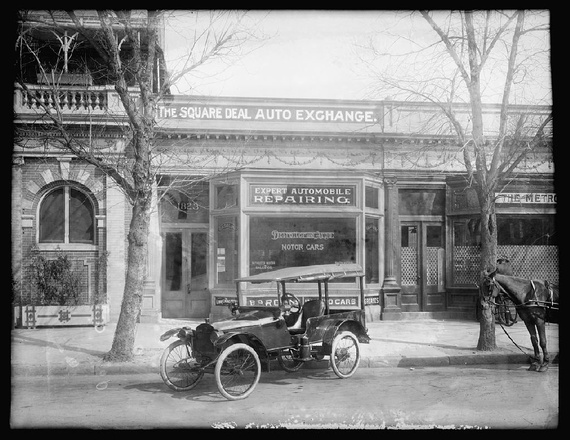
Station wagon in Washington, D.C., 1915 (Library of Congress)
In the 1920s, motorcars were becoming more widespread in America. By 1929 they were less of a toy for the rich and more of a necessity for everyone. To fulfill the need, wagon builders—small manufacturers who typically built these hybrid vehicles (yes, these were hybrids before hybrids became cool) per order—began to advertise them in popular magazines targeted for upper-class citizens likeCountry Life. Often referred to as “depot hacks,” these models were rugged and simple in design, able to travel rough roads that regular cars couldn’t. Consider them to be the first SUVs or crossovers, if you will; well, sort of. While modern SUVs and crossovers are owned by people from all social classes and driven everywhere, their earlier counterparts were priced higher and made-to-order, meant to be driven around the estate grounds after an afternoon of hunting, perhaps.
In 1923, Star, a division of Durant Motors—a short-lived automotive company that was meant to be direct competition of General Motors—was the first car company to offer a factory-built station wagon.
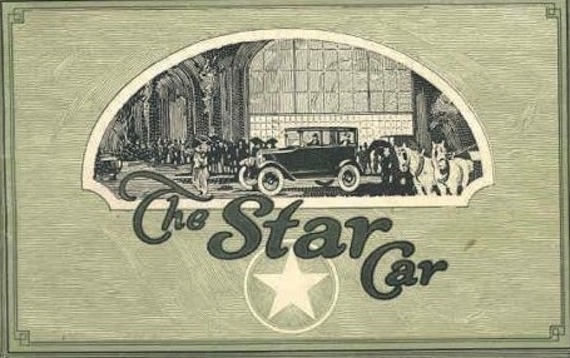
1923 sales brochure (screenshot from eBay)
Within a few years, wagon companies like Cantrell, York, Ionia, and Hercules began to emerge. Ford Motor Company began producing its own station wagon in 1929, marking the first time a station wagon was part of a regular catalog. Popularity for Ford’s product soared. The company made 5,200 of them that year, selling at $695 each.
By the 1930s, wood-bodied station wagons, or Woodies, as they were often called, had gained some prestige. They were priced higher than regular cars and popular in affluent communities.

1930s Ford woodie (Brian Snelson/Wikipedia)
But, they required constant maintenance—the bodies had to be varnished periodically and as the wood expanded and contracted with the weather, bolts and screws had to be tightened and retightened. Later, when all-steel wagons were introduced, faux-wood trim became popular on various models as an ode to the earlier all-wood designs.
When Dodge and Plymouth began producing station wagons, the bodies were still made out of wood but the designs were more streamlined with curved roofs that allowed rainwater to flow down the side of the body better. The Dodge Winchester was the first wagon to introduce roll-up front door windows instead of the side curtains.
In 1935, Chevrolet introduced the CarryAll, which later became known as the Suburban. Based on the 1933 and 1934 model built exclusively for the National Guard units, this commercial version was guilt on the same half-ton truck frame as the earlier models but featured all-metal wagon bodies resembling the popular woodie wagons of the time. It had windows, two removable upholstered seats and room for eight people.

It’s argued whether this was the first all-steel station wagon, as many considered it more of a light truck. If that’s the case, the first all-steel, car-sized wagon would have been the 1946 Willlys Jeep station wagon, which was based on the Willys-Overland jeep produced during World War II. The steel construction, of course, was far sturdier than wood and required less maintenance. And it was cheaper and less noisy.
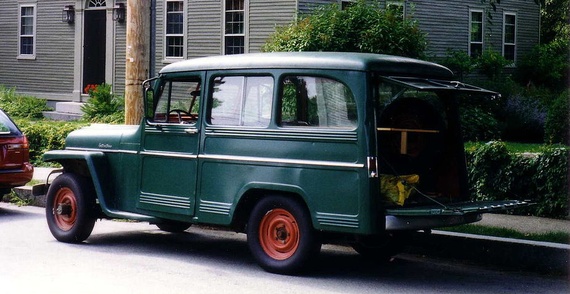
Jeep wagon (Christopher Ziemnowicz/Wikipedia)
The Jeep wagon was the first to offer painted faux-wood trim work, mimicking the earlier wooden models. By the late 1950s, wood accents on all-steel bodies were commonplace, one of the most popular models at the time being Ford’s Country Squire with simulated wood paneling.
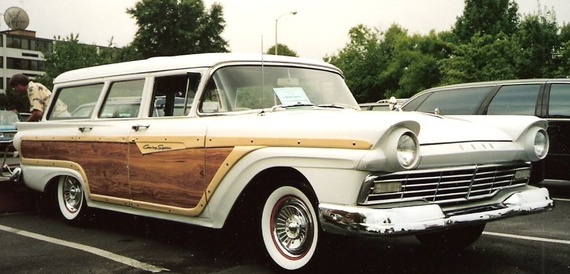
1957 Ford Country Squire (Josephew/Wikipedia)
After World War II, the era of summer family vacations began as many job benefits expanded to allow more time off. Car ownership became more widespread and new, government-funded highways were being built. Station wagons were there to meet the demand for family trips during the baby boom generation.
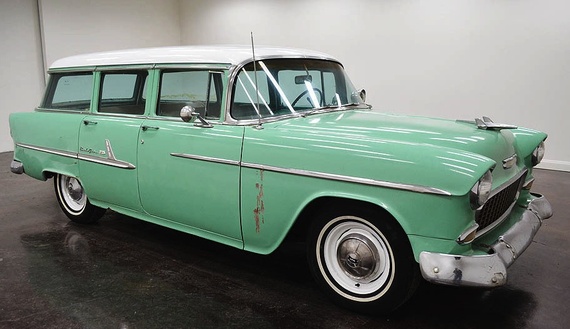
Car companies began making larger wagons—full-sized wagons—with six and nine-passenger seating to accommodate larger families and America’s newfound freedom of mass material consumption in the golden age of tourism. These full-sized wagons had forward-facing and rear-facing third row seats that folded down for hauling luggage, groceries and pretty much anything else, along with two-way and three-way tailgates with retractable windows, along with sliding roof panels, and liftbacks for versatility. Because of the widespread availability of station wagons, and the many different styles in which they were offered, they became a product more for functionality rather than style or status.
Between the 1950s and the 1970s, the popularity of the station wagon experienced an all-time high in the United States. But by the mid ‘70s, sales declined for a few reasons. The 1973 oil crisis—in which oil prices jumped from $3 a barrel to $12—didn’t help the cost of fueling the mighty V8 engines of these full-sized beasts.
And then the minivan happened.






 京公网安备 11010802032529号
京公网安备 11010802032529号